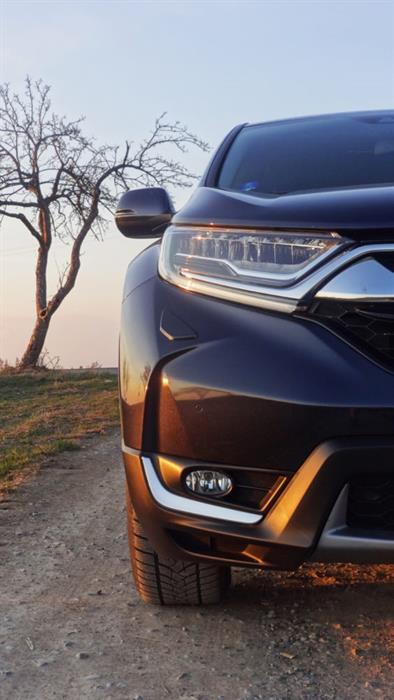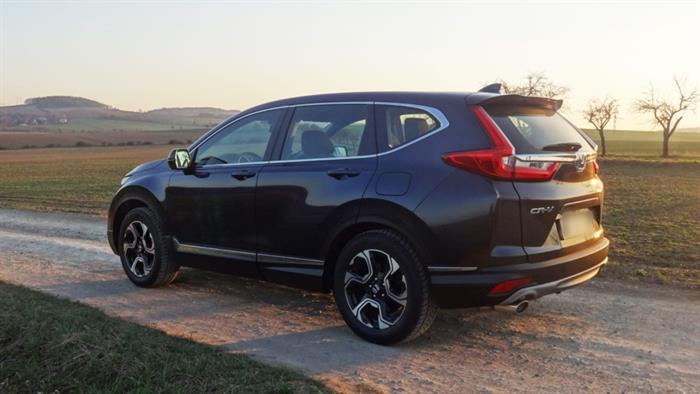The Honda CR-V, a long-standing fixture in the Japanese automaker's portfolio, was introduced to us last summer with the fifth generation of this successful model. I currently got a piece with a gasoline turbocharged engine, six-speed manual transmission, front-wheel drive and Elegance equipment in the editorial test.

The fifth generation and its powertrain
The current fifth generation has rejected diesel units and is betting only on a petrol turbocharged "fifteen" and on a technologically completely new hybrid. The tested turbocharged four-cylinder is available in two performance variants. The weaker one, with an output of 127 kW (173 hp), is mainly connected to front-wheel drive and a six-speed manual, while the stronger 142 kW (193 hp) is also available in four-wheel drive or with a CVT automatic .
I would praise the tested engine for its smooth pull, practically in the entire range of revolutions, without any indication of its turbocharging. Even the sportier character of the drive is no stranger to this motorization, its more substantial sound only supports this character of the drive. Traditionally, I have to praise the six-speed manual, the paths of the gear shift are precise and short, and the shift itself is accompanied by a pleasantly light resistance. The gears are set rather more to pull and at highway speed, in sixth gear, the engine spins slightly over three thousand revolutions. The six is therefore somewhat stronger than is usually the case (however, the engine works in a wide range of revolutions), as a result of which there is better acceleration to the sixth gear without the need to downshift.
The combination of this engine and gearbox then claimed an average of 7.4 liters per hundred kilometers during the week-long test. Colleague Martin is currently testing a CR-V with a more powerful "fifteen" equipped with AWD drive and an automatic, I'm honestly curious to see where he will move with consumption.
Driving the fifth generation CR-V is very comfortable and quiet. Here, Honda has worked extensively on the noise reduction of the car itself, not only by using damping materials, but also, for example, with the ANC system. With the help of two microphones, it picks up the noise coming from the drive unit in the cabin, then on the basis of the inverted deflection of the sound oscillations, it dampens these unfavorable sounds through the speakers.
A well-tuned chassis and steering contribute to a comfortable experience. In terms of chassis, the fifth generation works with a multi-element axle at the back, and at the front with a classic McPherson. As a result, the chassis is very comfortable, yet also very secure with a sharper driving style.
The CR-V works with electromechanical power steering. This system then has a pair of pinions, or a variable steering gear. As a result, the steering is direct with a very good and immediate response.
The overall driving experience of the tested fifth generation is therefore very good. In addition to the linearly retracting motorization and the pleasantly functioning manual, let's add nimble steering and a comfortably tuned chassis.
Perhaps the only blemish on the beauty of the tested car was the function of the electromechanical parking brake on the mechanical side. It simply tries to teach you to apply the handbrake before turning off the engine every time. Unfortunately, the brake does not apply automatically and before every start, if the parking brake is not applied, the same scenario takes place over and over again. The vehicle simply cannot be started without the handbrake applied, i.e. first apply the handbrake and then start. A rather annoying detail, but I suppose you can get used to it.

Proven external appearance
The time-tested external appearance of the car has not changed much from the third to the current fifth generation. The CR-V does a very good job of deceiving the body, and as a result, it doesn't look as big as it really is. As for the front part, here I would highlight its sandwich arrangement, loading of the mask part, headlights and the entire hood on the bumper and front edges, fenders of the car. This detail lightens the car, and yet gives it a clearly visible robustness. The rear part is then dominated by new horizontally and vertically oriented lamps. The horizontal proportion prevails here and again supports the robustness of the entire car. Yes, even in the second lowest Elegance trim, the fifth generation Honda CR-V is a very presentable and handsome car.

Spacious interior
The interior will certainly delight you with the already mentioned spaciousness. But let's start with the rear seats, which have a lot of space, and not just in the legroom. Another positive of this part of the car is the possibility of opening the side doors almost at a right angle. The seats are generously dimensioned, and when the backrests are folded down, the seats themselves easily move more towards the floor, improving the flatness of the luggage compartment storage area. It has a basic volume of 561 litres, after folding down the backrests subsequently 1756 litres. The loading edge is set quite low for the given segment, but it is worse with the lid of the luggage compartment itself and its height when folded, taller figures could have a bit of a problem here.
In the front part of the interior, as part of the fifth generation, we also received light retouches. The dashboard of the tested car, quite traditionally for today, is dominated by a seven-inch touchscreen infotainment display, which is quite nicely integrated together with the air conditioning selectors into one curved plate. As far as the infotainment controls are concerned, Honda traditionally has a somewhat more complicated environment that requires a bit of getting used to. The instrument panel in front of the driver is fully digital, the display with information on revolutions and a digital speedometer also has switchable information on consumption, radio, navigation, etc. On the sides there are temperature and remaining fuel indicators, and in the upper part a discreet light line that changes its color spectrum according to your current driving style.
I have already praised the pleasant mechanical operation of the shift lever, as well as its ergonomically ideal placement in the area of the dashboard. For me, the weak point of the interior was the wooden paneling, which in the end did not seem integrated at all. Even so, the interior of the fifth generation Honda CR-V deserves praise, mainly for its tremendous spaciousness.

Conclusion
The basic price of a car with a weaker 1.5 VTEC TURBO gasoline engine (127 kW) with a six-speed manual transmission, 2WD drive and Comfort equipment starts at 669,900 CZK including VAT. You can buy the piece tested by us with the same engine, gearbox and 2WD drive but with the Elegance equipment from 749,900 CZK including VAT.
For the sake of interest, you can buy the cheapest four-wheeler from CZK 799,900 including VAT, it has the Elegance equipment, a weaker gasoline engine and a six-speed manual. The cheapest Hybrid then from 769,900 CZK including VAT.
The fifth generation Honda CR-V is a car that offers a decent and robust exterior. I attribute the similarity to the previous generation, although it is a completely new car, to a certain application of a proven functional solution. Simply what works doesn't need to be changed. Other positives of the CR-V are undoubtedly a large interior space, a continuously engaging drive unit, a comfortable, quiet chassis and precise steering.
If I forget about the ailments of having to apply the handbrake, or the traditionally complicated infotainment system, which I assume you will get used to quickly as a car owner, the fifth generation Honda CR-V is a spacious car that will also offer you a very pleasant driving experience.




























